仁爱版英语九年级(上册)说课稿Unit2Topic
- 格式:doc
- 大小:32.50 KB
- 文档页数:9
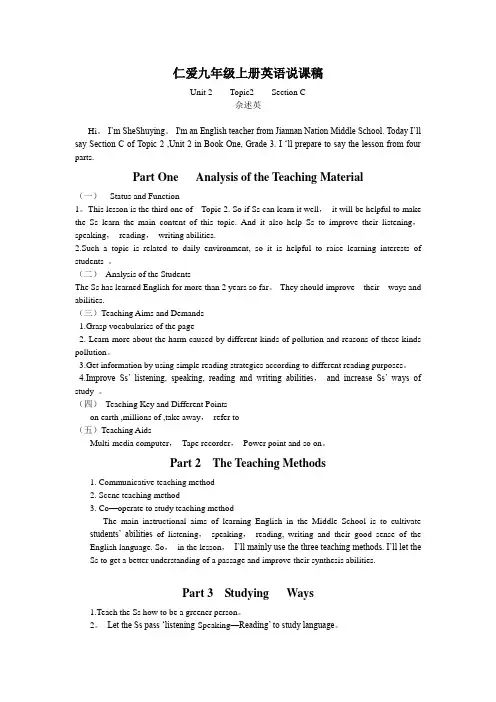
仁爱九年级上册英语说课稿Unit 2 Topic2 Section C佘述英Hi。
I’m SheShuying。
I'm an English teacher from Jiannan Nation Middle School. Today I’ll say Section C of Topic 2 ,Unit 2 in Book One, Grade 3. I ‘ll prepare to say the lesson from four parts.Part One Analysis of the Teaching Material(一)Status and Function1。
This lesson is the third one of Topic 2. So if Ss can learn it well,it will be helpful to make the Ss learn the main content of this topic. And it also help Ss to improve their listening,speaking,reading,writing abilities.2.Such a topic is related to daily environment, so it is helpful to raise learning interests of students 。
(二)Analysis of the StudentsThe Ss has learned English for more than 2 years so far。
They should improve their ways and abilities.(三)Teaching Aims and Demands1.Grasp vocabularies of the page2. Learn more about the harm caused by different kinds of pollution and reasons of these kinds pollution。
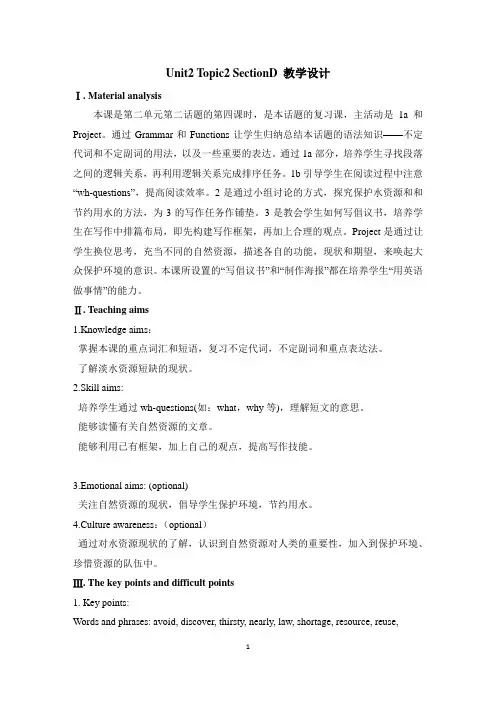
Unit2 Topic2 SectionD 教学设计Ⅰ. Material analysis本课是第二单元第二话题的第四课时,是本话题的复习课,主活动是1a和Project。
通过Grammar和Functions让学生归纳总结本话题的语法知识——不定代词和不定副词的用法,以及一些重要的表达。
通过1a部分,培养学生寻找段落之间的逻辑关系,再利用逻辑关系完成排序任务。
1b引导学生在阅读过程中注意“wh-questions”,提高阅读效率。
2是通过小组讨论的方式,探究保护水资源和和节约用水的方法,为3的写作任务作铺垫。
3是教会学生如何写倡议书,培养学生在写作中排篇布局,即先构建写作框架,再加上合理的观点。
Project是通过让学生换位思考,充当不同的自然资源,描述各自的功能,现状和期望,来唤起大众保护环境的意识。
本课所设置的“写倡议书”和“制作海报”都在培养学生“用英语做事情”的能力。
Ⅱ. Teaching aims1.Knowledge aims:掌握本课的重点词汇和短语,复习不定代词,不定副词和重点表达法。
了解淡水资源短缺的现状。
2.Skill aims:培养学生通过wh-questions(如:what,why等),理解短文的意思。
能够读懂有关自然资源的文章。
能够利用已有框架,加上自己的观点,提高写作技能。
3.Emotional aims: (optional)关注自然资源的现状,倡导学生保护环境,节约用水。
4.Culture awareness:(optional)通过对水资源现状的了解,认识到自然资源对人类的重要性,加入到保护环境、珍惜资源的队伍中。
Ⅲ. The key points and difficult points1. Key points:Words and phrases: avoid, discover, thirsty, nearly, law, shortage, resource, reuse,take sth. away from…, the shortage of water / water shortage, avoid (doing) sth., make progress in, nearly 3/4 of…2. Difficult points:学会归纳话题中的重点语法和表达法。

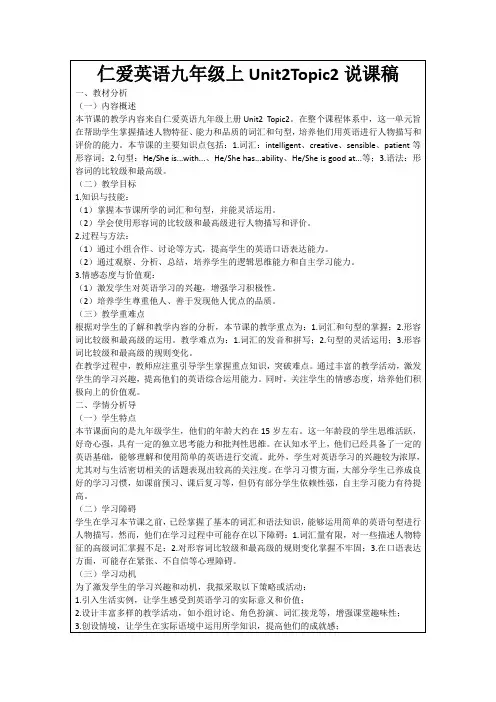
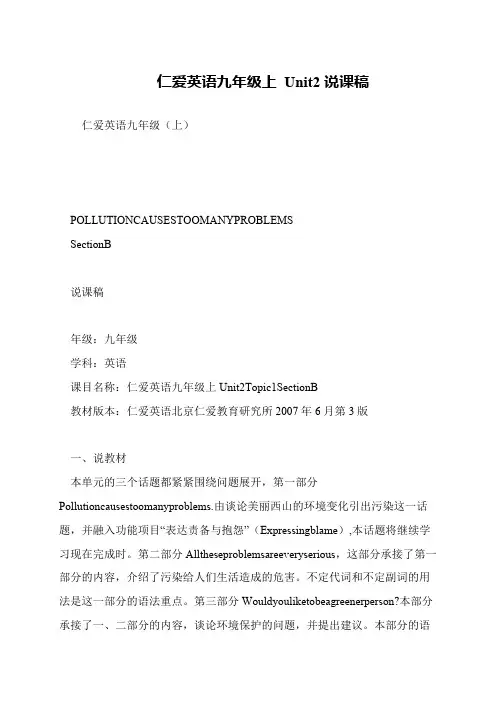
仁爱英语九年级上Unit2说课稿
仁爱英语九年级(上)
POLLUTIONCAUSESTOOMANYPROBLEMS
SectionB
说课稿
年级:九年级
学科:英语
课目名称:仁爱英语九年级上Unit2Topic1SectionB
教材版本:仁爱英语北京仁爱教育研究所2007年6月第3版
一、说教材
本单元的三个话题都紧紧围绕问题展开,第一部分Pollutioncausestoomanyproblems.由谈论美丽西山的环境变化引出污染这一话题,并融入功能项目“表达责备与抱怨”(Expressingblame),本话题将继续学习现在完成时。
第二部分Alltheseproblemsareeveryserious,这部分承接了第一部分的内容,介绍了污染给人们生活造成的危害。
不定代词和不定副词的用法是这一部分的语法重点。
第三部分Wouldyouliketobeagreenerperson?本部分承接了一、二部分的内容,谈论环境保护的问题,并提出建议。
本部分的语。
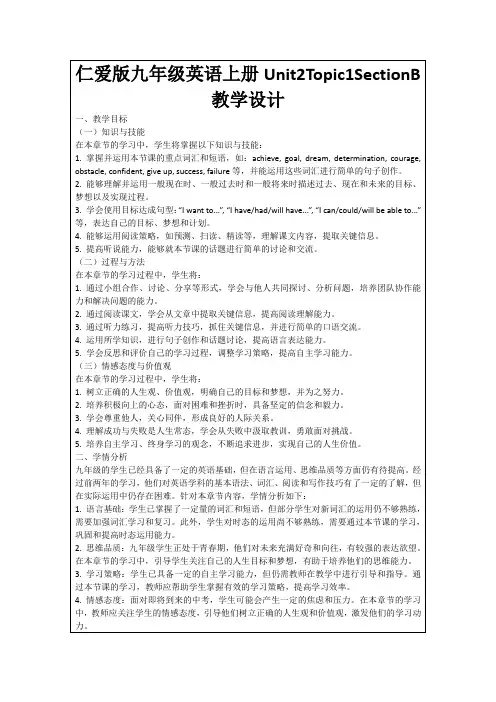
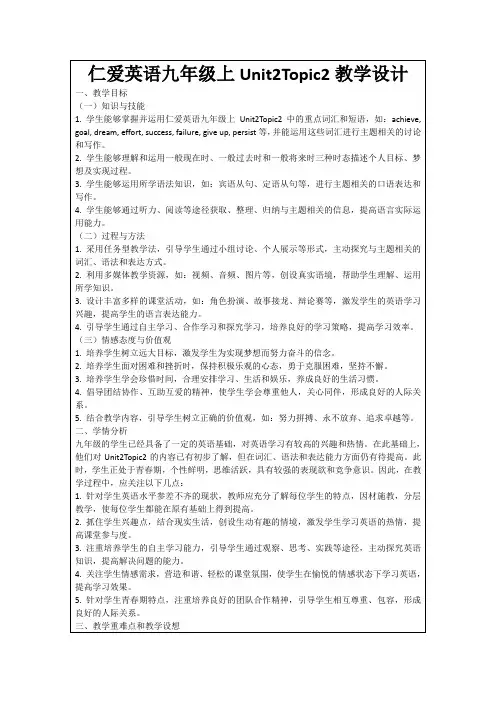
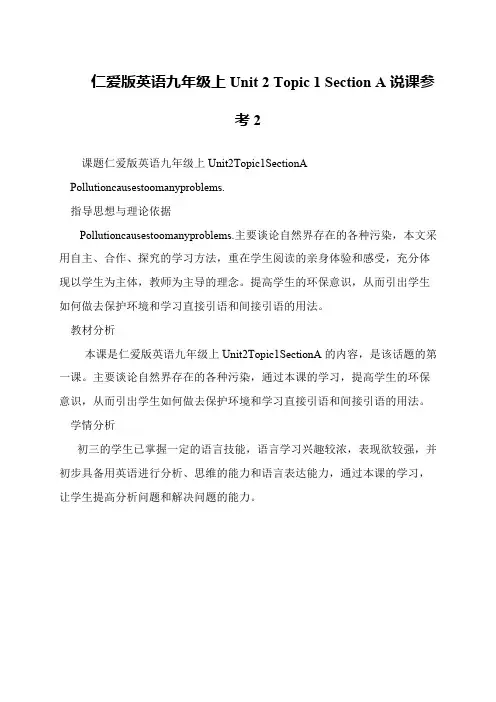
仁爱版英语九年级上Unit 2 Topic 1 Section A说课参
考2
课题仁爱版英语九年级上Unit2Topic1SectionA
Pollutioncausestoomanyproblems.
指导思想与理论依据
Pollutioncausestoomanyproblems.主要谈论自然界存在的各种污染,本文采用自主、合作、探究的学习方法,重在学生阅读的亲身体验和感受,充分体现以学生为主体,教师为主导的理念。
提高学生的环保意识,从而引出学生如何做去保护环境和学习直接引语和间接引语的用法。
教材分析
本课是仁爱版英语九年级上Unit2Topic1SectionA的内容,是该话题的第一课。
主要谈论自然界存在的各种污染,通过本课的学习,提高学生的环保意识,从而引出学生如何做去保护环境和学习直接引语和间接引语的用法。
学情分析
初三的学生已掌握一定的语言技能,语言学习兴趣较浓,表现欲较强,并初步具备用英语进行分析、思维的能力和语言表达能力,通过本课的学习,让学生提高分析问题和解决问题的能力。

Unit2 Topic1 Pollution causes too many problems. Section D说课稿Good morning, ladies and gentlemen!My name is _______________and I graduated from __________________. Today I’ll talk about Unit 2 ,Topic1 Pollution causes too many problems. Section D. My teaching plan has six parts.Part One: Analysis of the teaching material1、Function of the teaching materialThis section is an important part of Topic1. It mainly talks about pollution , review Direct and Indirect Speech, so it is very important in this topic.2、Teaching aims(1)Knowledge aims: let the students master some new words and phrases, understand the reading passage and learn how to change Direct Speech into Indirect Speech.(2)Ability aims: improve the students’ ability of listening, reading, speaking and writing.(3)Emotional aims:let the students know about pollution, realize the importance of protecting the environment and do something for it.3、Important points and difficult pointsThe important points are the new words and phrases, the reading passage and the grammar. The difficult point is how to change Direct Speech into Indirect Speech.Part Two:Analysis of the studentsThe students of this stage are eager to learn new things and are quick in thought. They have also learned something about noise pollution. So it is very good for their further study.Part Three: Teaching methodsIn this lesson, I’ll use the Scene Teaching method, the Task-based teaching method and the Communicative teaching method.Part Four Teaching ProcedureStep 1 RevisionIn this step, first we’ll review Section C: Noise Pollution. Then I’ll lead in this section: Let’s talk about the harm that the pollution causes.Step2: PresentationIn this step, I’ll show the students some pictures. These pictures are all about the problems caused by pollution. Then I’ll ask the students to talk about each picture. This step is to attract the students’ interest in this topic. At the same time, the students can learn and master some key words ,such as “create”, “industry”, “destroy”, “blood”, and “pressure”.Step 3: Open learning(自主学习)In this step, I’ll ask the students to do some exercise. Theses exercises are for the new words and phrases and are very easy. Then I’ll check the answers with the students.Step 4 Reading and listeningThis step has 3 tasks.Task 1 is fast reading. I’ll ask the students to read the text quickly and find out how many problems are talked about. This can train the students to find information quickly.Task 2 is careful reading. I’ll ask the students to read the text carefully and do some True or False exercises. This can help the students to find details.Task 3 is pair work. I’ll design a form. The students are asked to listen to the text part by part and finish the task. They can work in pairs. This can help the students understand the text deeply and clearly and learn to study together.Step 5 SpeakingLet the students work in groups and talk about these questions:1) What problems has pollution caused?2) How can we solve these problems?Then I’ll ask the students to report their answers.Step 6 GrammarIn this step, I’ll show the students some sentences in Direct Speech and ask them to change into Indirect Speech. If the students have some difficulty, I’ll give them necessary instructions.Part Five : Blackboard DesignI’ll divide the blackboard into three parts. On the left, I’ll write the key words and phrases. In the middle, I’ll write the examples. On the right, the students can write their answers to the exercises.Part Six HomeworkI’ll ask the students to write a composition “My Ideal School”. The students can use what they have learned in class and can understand the topic better.That’s all of my speech. Thank you for listening.。
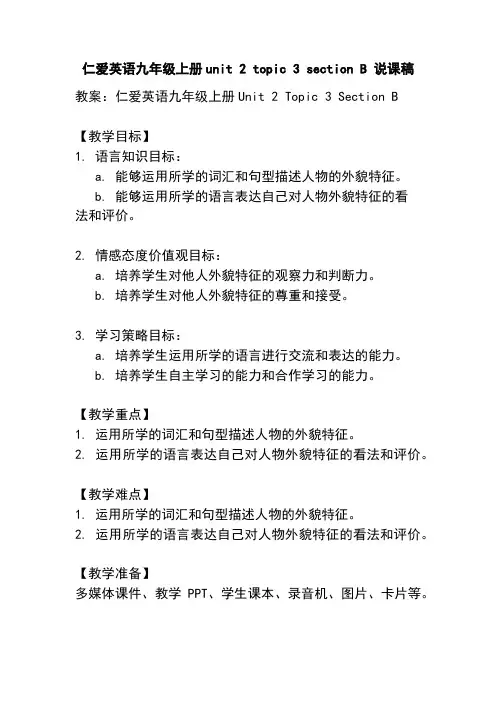
仁爱英语九年级上册unit 2 topic 3 section B 说课稿教案:仁爱英语九年级上册Unit 2 Topic 3 Section B【教学目标】1. 语言知识目标:a. 能够运用所学的词汇和句型描述人物的外貌特征。
b. 能够运用所学的语言表达自己对人物外貌特征的看法和评价。
2. 情感态度价值观目标:a. 培养学生对他人外貌特征的观察力和判断力。
b. 培养学生对他人外貌特征的尊重和接受。
3. 学习策略目标:a. 培养学生运用所学的语言进行交流和表达的能力。
b. 培养学生自主学习的能力和合作学习的能力。
【教学重点】1. 运用所学的词汇和句型描述人物的外貌特征。
2. 运用所学的语言表达自己对人物外貌特征的看法和评价。
【教学难点】1. 运用所学的词汇和句型描述人物的外貌特征。
2. 运用所学的语言表达自己对人物外貌特征的看法和评价。
【教学准备】多媒体课件、教学PPT、学生课本、录音机、图片、卡片等。
【教学过程】Step 1:导入新课(5分钟)1. 向学生展示一张图片,让学生观察图片中的人物外貌特征。
2. 引导学生用英语描述图片中的人物外貌特征。
Step 2:新课讲解(15分钟)1. 向学生展示并讲解新词汇,如hair, eyes, nose,mouth等。
2. 向学生展示并讲解新句型,如What does he/she look like? He/She has...等。
3. 向学生展示并讲解相关的语法知识,如形容词的用法和位置等。
Step 3:练习与巩固(15分钟)1. 让学生听录音,跟读并模仿录音中的对话。
2. 分组让学生进行对话练习,描述自己或他人的外貌特征。
3. 让学生用所学的语言描述一位名人的外貌特征,并向同伴介绍。
Step 4:拓展与运用(10分钟)1. 让学生观察教师给出的一些图片,并用所学的语言描述图片中的人物外貌特征。
2. 让学生自由发挥,用所学的语言描述自己或他人的外貌特征,并向同伴介绍。

仁爱九年级英语上册unit 2 Topic 1 Section A 公开课教学设计教学内容:教材P25中 1a, 1b及p26中3a有关环境污染话题及相关练习和语法知识。
教学课时:估计一课时教学课型:听说课教学目标:1.知识与技能①.词汇:bee, waste, stream, influence, breathe②.语法:直接引语与间接引语③.话题:表责备与抱怨、不同的污染及其原因2.过程与方法运用教材及幻灯片进行听读的练习,结合实际生活实例进行商量〔说〕的练习,再进行写的练习,把所学、所见、所论写下来3.感情态度与价值观树立学生的环保意识,增强社会责任感和忧患意识。
教学重点:P25中 1a, 1b及p26中3a有关环境污染话题教学难点:用直接引语和间接引语商量环境污染话题教学方法:观察法,商量法,讲授法,练习法教学设备:ppt课件,录音机教学环节:Step 1 ReviewDuty reportT: If you want to go for a picnic, what place would you like to go (Or Help students anwser)We want to go to clean and beautiful places for a picnic.We would like to some places with green trees and flowers.Show some pictures about “pollution〞, 让同学们了解我们周围有哪些污染。
Step 2 Presentation(By flashcard)What can you see in picture 1Get them to describe it according to the key words and drills on the blackboardThen picture 2播放录音,认真听加深俩图对比,让学生在比照中复述1aStep 3 Consolidationn讲解短语和重点句型Step 4 Practice直接引语转换间接引语的引导和讲解Step 5 Project and homework1,观察周围有哪些污染,这些污染是如何产生的以及带给我们的危害。
仁爱版九年级UNIT2TOPIC1SECTIOND说课稿英文-医药卫生仁爱版九年级**********TION D说课稿英文说课稿Good afternoon, ladies and gentlemen. My name is Fan Chang. Today I’m going to talk about the topic ”Pollution has caused too many problems ”. I will divide the instruction into four parts:they are Teaching Material Analysis, Teaching Method Analysis, Learning Method Analysis, and Teaching procedures.Part 1 Teaching Material Analysis1. Teaching aimsThis section is from Topic 1 of Unit 2. According to the textbook, I determine the teaching aims are as follows:(1) Knowledge objectsa. Let the students know how to use simple past and present perfect.b. Enable the students to remember the new words phrases.c. Make the students learn by themselves.(2) Ability objectsa. Make the students understand the passage about pollution.b. Ask the Students to make dialogues using the new words andphrases.b. Stimulate students' interest in learning English.(3) Moral objectsa. Let the students know something about pollution.b. Guide the students understand the importance of environmental protection, and do what they can to protect the environment.2. Teaching important pointsa. New words and phrasesb. improve their reading skills.3. Teaching difficult pointsa. Act out students’ ow n dialogue using new words and phrases.b. Grasp the transformation of synonymous sentences.Part 2 Teaching Method Analysis1. Use pictures to create scenarios for students to learn new knowledge, and inspire students to learn.2. Use discussion and conversation practice to let the students improve the ability of using language in order to achieve the purpose of communication, so that students can apply their knowledge to the knowledge.Part 3 Learning Method Analysis1. Autonomous learning. It is to cultivate the independent exploration ability of students, to make them learn to study.2. Collaborative learning. It is to cultivate the cooperation and communication ability, and team consciousness of students.Part 4 Teaching proceduresStep 1 ReviewFirst of all, review and consolidate Section A-C through the Grammar and Functions practice. And then introduce the new lesson: Let 's talk about some kinds of pollution.Step 2 PresentBy the use of pictures show the different kinds of pollution and teach the important new words, presenting 1a. Learn and master “coal", "create", "blood", "pressure" and "planet".Step 3 Learn by themselves仁爱版九年级**********TION D说课稿英文Read 1a, fill in the blanks according to the contents of the article. Then the teacher and students discuss the answers together.Step 4 ConsolidateRead 1a again, find out the harm of each kind of pollution. Let the students discuss by groups: what harms does the pollution around us do to our environment? How can we solve them?Step 5 PracticeCompleted 1b. Explain the synonymous sentences.Step 6 Afterschool activitiesThrough group activities, make Blackboard newspaper about "protect the environment and be green angels" after class. Finish Project.Step 7 HomeworkAsk the students to write an article entitled "My Ideal School", imagining their ideal campus.That’s all. Thank you!。
仁爱九年级上册英语说课稿Unit 2 Topic2 Section C佘述英Hi. I’m SheShuying. I’m an English teacher from Jiannan Nation Middle School. Today I’ll say Section C of Topic 2 ,Unit 2 in Book One, Grade 3. I ‘ll prepare to say the lesson from four parts.Part One Analysis of the Teaching Material(一) Status and Function1.This lesson is the third one of Topic2. So if Ss can learn it well, it will be helpful to make the Ss learn the main content of this topic. And it also help Ss to improve their listening, speaking, reading, writing abilities.2.Such a topic is related to daily environment, so it is helpful to raise learning interests of students .(二) Analysis of the StudentsThe Ss has learned English for more than 2 years so far. They should improve their ways and abilities.(三)Teaching Aims and Demands1.Grasp vocabularies of the page2. Learn more about the harm caused by different kinds of pollution and reasons of these kinds pollution.3.Get information by using simple reading strategies according to different reading purposes.4.Improve Ss’ listening, speaking, reading and writing abilities, and increase Ss’ ways of study .(四) Teaching Key and Different Pointson earth ,millions of ,take away, refer to(五)Teaching AidsMulti-media computer, Tape recorder, Power point and so on.Part 2 The Teaching Methods1. Communicative teaching method2. Scene teaching method3. Co-operate to study teaching methodThe main instructional aims of learning English in the Middle School is to cultivate students’ abilities of listening, speaking, reading, writing and their good sense of the English language. So, in the lesson, I’ll mainly use the three teaching methods. I’ll let the Ss to get a better understanding of a passage and improve their synthesis abilities.Part 3 Studying Ways1.Teach the Ss how to be a greener person.2. Let the Ss pass ‘listening—Speaking—Reading’ to study language.3. Teach the Ss how to master the passage and how to communicate with others.Part 4 Teaching ProcedureI’ll finish this lesson in 5 steps.Step1 ReviewT says: Look at the pictures in 1a.Discuss in groups about what pollution human activities bring and what problems the pollution causes. Then get several students to report the results of their discussion.Purpose of my designing: let the students to report the results of their discussion., and lead to today’s content.Step 2 PresentationFirst, Let students think about some questions given by the teacher according to the pictures in 1a. The questions are:(1)What is the ozone layer?(2) What does the ozone do? Is it good or bad for us?(3) What problem will the rise of carbon dioxide cause?Second ,let students read 1a with these questions and answer them. Then read 1a again and choose a suitable title for each paragraph by using the reading skills we have. Master the new words.Purpose of my designing: Let the students the main idea of each paragraphStep3 consolidation1.Let students choose the best answers according to 1a,and finish 1b .2.Let students find out the difficult points in 1a and solve them with the teacher.Purpose of my designing: let students under the text deeply.Steps 4 Practice1.divide the class into two groups. let two groups find out the influences of O3 ,CO2 andthe greenhouse effect on the environment. Finish 22.Discuss:What should we do to protect the earth?Purpose of my designing: let students know about the influences of O3 ,CO2 and the greenhouse effect on the environment. Learn to how to protect the earthStep 5 Project。
仁爱版九年级英语上册Unit2 Topic 1 Section A说课
参考
课题仁爱版九年级英语UNIT2Topic1SectionA
Pollutioncausestoomanyproblems
教材分析
1.本节课是选自仁爱版九年级英语上册Unit2Topic1SectionA:Pollutioncausestoomanyproblems.SectionA紧紧围绕环境问题展开,由学生谈论曾经去过的旅游地点导入康康等几个小主人公选择野餐地点的生活场景,引导学生评价、介绍目的地,并导入新课谈论西山环境的变化,同时巩固学习现在完成时,为现在完成时第二部分的教学打好基础;通过1b,初步了解直接引语和间接引语;通过2、3b的信息输入,引导学生关注环境并用英语介绍相关现象,培养和提高学生的环保意识。
2.本节课的核心内容是通过对话讨论“西山”环境的变化,复习旧的重点词汇、掌握新的重点词汇、巩固学习现在完成时、初步了解直接引语和间接引语,培养和提高学生的环保意识。
学情分析
1.兴趣方面:大部分九年级学生对英语缺乏兴趣,加上七、八年级就已经开始厌倦、甚至有放弃英语的念头,所以在课堂上很难调动起那种主动想学习的气氛来。
因此,作为一名新时代的英语教师,。
仁爱版英语九年级上册Unit2 Topic2 All these problems are very serious section A说课稿尊敬的各位老师,各位评委好:大家好!我是来自英语科组的参赛者伍世华。
今天我说课的题目是九年级英语Unit 2 Topic2 All these problems are very serious section A。
本次说课我将从五个方面向大家进行介绍,分别是:教材分析、教法分析、学法指导以及教学程序,板书说明,首先我说的是教材分析部分。
一.教材分析1、教材的地位和作用本课是仁爱版英语九年级上册第二单元第二话题Section A的内容。
本课是这个topic的开篇,主要以口语、听力练习、新知为主。
通过谈论天气这一话题,得出环境问题越来严重以及提出相关的保护措施-------种树plant trees,得知树木可以防风固土,防水土流失等作用,从而教育学生爱护环境,并为下面的学习做铺垫。
2、教学目标根据初中英语新课程标准的要求,结合课本教材,确定本节课的教学目标如下:即知识目标、技能目标和情感与态度价值观目标。
(1)知识目标:通过本课的学习,学生掌握一些词汇和语法知识,如,stop from doing sth ;while的用法;动名词作主语,让步状语的用法等,这是本节课所要达到的知识目标。
(2)技能目标:通过对本课对话的分析和学习,学生掌握用英语表达对天气的看法以及树木的作用。
(3)情感与态度价值观目标:通过学习本课,学生培养认真细致的学习态度,合作精神;以及树立爱护环境,保护树木的良好意识。
3、教学重点和难点重点:1,学生可以理解对话内容以及相关的语法知识2,学生会听,会朗读本课对话。
难点:1,学生在实际情境中熟练运用英语表达环境问题和树木作用。
2,学生会正确运用对话中的重要短语和一些语法知识,如stop......from doing sth;while的正确用法等。
二、教法分析以学生为主体,充分发挥学生运用语言的实践能力和创新能力,调动学生学习的积极性。
在本节课中,我主要采用:1、创设情景教学法2、听力训练法3、任务驱动教学法4、交际功能法三、说学法1、说学情从总体上的来说,本班的学生部分个性张扬而部分学生过于内向,不自信。
英语基础薄弱,英语口语能力和听力能力还有很大的发展空间。
学生对英语学习的兴趣不高,导致英语成绩两极分化,2、说学法就本班的学生的情况,我将引导学生采用以下两种方法进行学习,分别是:自主学习法和合作学习法。
四.教学程序本课将围绕教学五环中的复习,新授,巩固,练习,小结五个环节来进行教学活动。
第一步:复习导入a,播放本册书中的unit2topic1sectionA1a的影片。
问题:whatare they talking about?S1: .........S2: .........情境意义:这一环节我采用了创设情境教学法。
第一:播放视频短片,巧妙地引导学生把心思转移到课堂上。
第二:利用视频短片使学生融入讨论环境问题的情境当中。
播放完毕之后,老师提问:what are they talking about?让学生独自思考并回答问题。
这样也在无形当中引导学生运用了自主学习法。
因为视频短片内容简单,贴近生活,是学生已经学过的知识,所以大部分学生可以理解并回答这道问题。
在提问学生时,适当照顾基础较薄弱的学生,并及时给予肯定并表扬学生,给学生信心,从而使学生有动力,兴趣继续往下学。
在学生回答问题的时候,鼓励学生多说英语,可以用英语回答的尽量用英语回答,不能的用中文,并让会用英语回答的学生进行补充。
这样做可以训练学生的英语口语能力以及中英互译的反应能力,达到让学生多说英语的目的。
讨论T:what should we do to protect the environment?S3:......S4:.........情境意义:我使用了交际功能教学法,学生通过讨论进一步深入主题——如何保护环境,同时也是为下面的教学做铺垫。
引导学生合作学习,互相讨论,集思广益,在回答问题的时候也是鼓励学生多说英语,锻练了学生的口语能力。
在提问学生的时候,应当较全面地照顾个层次的学生,不要只顾着基础好学生的亦或者基础较弱的学生。
努力使学生们感觉到课堂是需要他们的,照顾学生的情感需要,更能调动学生的积极性。
当学生们说到plant more trees(多种树)的时候T:why we should plant more trees?What are the functions of trees?接着顺理成章进入第二环节——新授。
第二步:新授unit2 topic2 section Aa,听录音1a第一遍,回答问题并可对答案。
Question:The boys and girls are talking about_______?A,different types of sandstormsB,the reasons for sandstormsC,sandstorms in different cities情境意义:这我使用了听力训练法,听录音是学习英语的重要方法,也是语言的重要技能,学生通过听可以感知对话内容。
学生则是独立完成学习任务,给予学生独立思考的空间。
让学生带着问题听录音,并回答问题,达到对课文对话内容的初步理解的目的。
b,教师把课文对话中的内容里面的重点词组和句子挖空,让学生进行听力的训练。
听1a一道两遍。
并可对答案。
情境意义:这里也是运用了听力训练法。
通过听第二遍第三遍加深对课文的理解,完成听力任务,提高听力能力,训练学生听与写反应能力。
学生独立完成,通过核对答案,再次听录音的过程中检查自己的听力成果。
同时也突出了本课的重点短语及知识点。
c,听录音,跟读课文情境意义:我运用了听说训练法。
听,和读是语言的重要技能,学生通过听和模仿,提高听力能力,朗读能力。
d,小组合作,学习课文。
1,教师布置任务,学生小组合作完成任务。
任务:阅读课文1),用“*”标出你认为的重难点知识。
2),用“_____”划出以学过的词组和句型。
3),用“?”标出疑难。
本课的知识点:感叹句,while的用法,change......into,stop......from doing sth.,wash......away,blow......away,动名次作主语,让步状语though的用法等。
2,师生一起学习新课。
这环节主要是学生讲,教师听,纠正以及补充。
每小组学生代表说出一到两个知识点,学生之间互相提问,互相解答。
教师及时纠正和作最后的补充。
情境意义:这里我主要运用了任务驱动教学法和交际动能法。
给学生布置相应的任务,让学生以小组的形式进行自主学习,自行探索,互相讨论并解决问题。
这样可以提高学生的合作能力,解决问题的能力,增加生生之间的互动。
在活动中达到帮扶的作用,加深同学之间的友谊。
在一起学习新课当中,小组代表发言说出该小组找到的重难点,其他小组提供答案或者做相应的补充。
在这过程添加竞赛活动,激励学生活跃参与,锻炼学生的胆量,培养学生的竞争意识。
既有合作也有竞争,增添课堂乐趣。
也充分体现了先学后教。
第三步:巩固a,听1a,学生模仿跟读。
情景意义:运用听力训练法。
听录音,男女生分角色模仿跟读课文。
听说读写译重要的语言技能技能,多听多读是必不可少的,以此巩固课文对话,也避免了单一的朗读。
第四部步a,练习:( )1.The Green Great Wall can stop the wind_____ blowing the earth away.A.toB.fromC.ofD.with( )2.We must plant more trees after we _____ every year.A.take away themB.take them awayC.cut downthem D.cut them down( )3. _____Liang Li is very busy,she always helps others.A.ButB.AndC.AlthoughD.Because( )4.He is tall, _____ his son is short.A.whenB.orC.whileD.and( )5.I met my teacher _____ I was walking in the street, but I didn’t say hello to him.A.beforeB.afterC.untilD.while情景意义:课文对话中的一些知识点是中考知识点。
所以就重点以while的用法,感叹句,以及一些常考短语出一些练习。
让学生巩固新知,再次突出本课的知识点,并链接中考。
第五步:小结a,划出对话中有说到树木功能的句子并总结补充。
情景意义:本单元的话题主要是如何保护环境,而本课讲的是树木可以防风固土,防止水土流失,还可以吸入二氧化碳,呼出氧气。
总结这些句子对我们学生来说,以后在保护环境话题中,无论是口头表达还是书面表达都是有一定的作用。
8家庭作业最后,为了让学生能巩固本堂课所学内容,我将布置作业,让学生结合实际谈谈环境问题、写一篇题为“My Ideal School”的作文作为课堂延伸。
这个作业能使学生的学习都面向现实生活,从而增强学生的环保意识,达到本节课的情感目标。
以上就是我说课的内容,谢谢大家!。